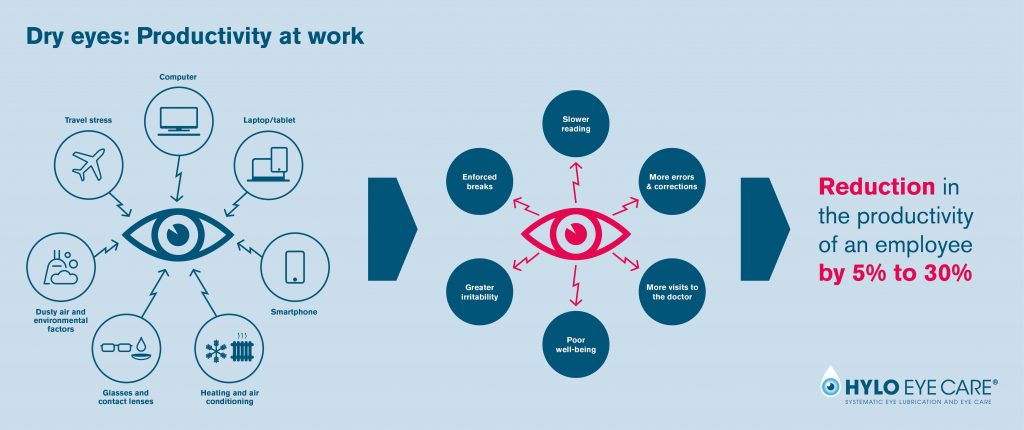Healthy eyes at work
The absence of sick employees costs the German economy well over €100 billion each year. Some of these absences can be traced back to stresses experienced in the workplace itself. The eyes also experience significant stresses on the job: For URSAPHARM ‘Workplace Eye Health’ means increasing the employers’ awareness of stresses in their workplaces and providing products that encourage eye health in a targeted and sustainable manner.
Digital information pack for companies
Get yours nowWhat are the stresses experienced by eyes in the workplace?
Whether it’s working in unnatural postures, permanent stress or an unhealthy diet: every day in the workplace many employees encounter a number of different sources of stress that they have to come to terms with. Our eyes also experience significant stress every day in the workplace, for example, due to:
- long hours working at computer screens
- dusty air in manufacturing jobs and trades
- dry air in heated or air-conditioned offices
- large amounts of reading time (for example, files)
- working under artificial ventilation (for example, in laboratories)
These factors favour the development of the symptoms typical of dry eye (e.g. itching, burning, red or tired eyes) at work. Together with personal use of, e.g., smartphones or tablets, eyes experience high daily stress overall. These days, the average time spent using digital screens is five to seven hours a day across all age groups. In light of this, it is hardly remarkable that dry eye is well on the way to becoming a disease affecting the entire population, with 12 million people already currently affected in Germany.
In the area of Corporate Health, the issue of “eyes at work” is now regulated by the Prophylaxis in Occupational Medicine, Guidelines for Occupational Medicinal Examinations (G37) of the German Social Accident Insurance (DGUV). Workplace eye examinations primarily cover employees’ visual acuity or existing impaired vision (e.g. using vision testing), with the prevention of dry eye barely rating a mention. The current rate of digitisation means it can be assumed that the stresses placed on eyes in the workplace will continue to rise.
Get your free digital information pack now!



How do dry eyes affect the productivity of employees?
Dry eyes are not only very unpleasant for those affected but also pose a challenge for companies. The symptoms of dry eyes cause many minor hindrances and interruptions in the workplace (e.g. rubbing of eyes, slower reading), which are in some cases not even perceived as limitations by those affected. For this reason, they are also given little weight by companies. Studies estimate the loss in productivity caused by the symptoms of dry eye to be 5 %. In some cases with severe symptoms, the limitation even reaches values of up to 30 %. The loss in productivity caused by dry eyes is therefore of an order of magnitude comparable to the limitations experienced by employees who go to work with severe headaches or a cold.
What does ‘Workplace Eye Health’ achieve?
As part of workplace health management, workplace eye health is one of the areas in which prevention and relief of symptoms can be achieved by relatively simple means. Targeted, needs-based measures can make a noticeable contribution to increasing employees’ awareness of the issue of eye health and encouraging them to manage their own eye health.
Companies benefit primarily from these advantages:
For an average employee a slight reduction in productivity of 5 % corresponds to a loss of €3775 per year in gross value added (based on the 2018 national accounts for Germany). Companies can counteract these reductions in productivity by informing their employees about the issue of eye health and giving them access to the right ‘tools’. These include:
- relaxation exercises for the eyes that can be integrated into the daily routine at work
- lubricating eye drops if symptoms should develop and for daily care of stressed eyes
- the correct ergonomic (e.g. lighting conditions, workplace design) and technical conditions (e.g. low-radiation monitors, blue light filters)
These tools will specifically reduce the effect of risk factors and also improve the health literacy of employees regarding their eyes. With this repertoire, employees can help themselves should minor symptoms develop – right in the workplace (preparatory measure), during work hours and with minimal time required.
The preservation and promotion of the health of employees are playing an increasingly significant role as part of corporate responsibility. Dry eye is becoming a disease of civilisation and will not stop for companies as a result of increasing digitisation. Information and preventive measures enable employers to show that they have identified this challenge in good time and that their workplace health management is state of the art – a driver of a company’s appeal as an employer.
Proactive engagement of an employer with the health of its employees will also be rewarded with greater satisfaction, better motivation and longer allegiance to the employer. This means that everyone benefits from measures implemented as part of workplace health management: both employees and the company itself.
Encourage eye health with URSAPHARM
The eyes are our most sensitive sensory organ and are also subjected to significant stresses at work – this is precisely where we address the issues:
- increase awareness of employers about the stresses and potentials in their own company
- show employees how they can easily contribute to the health of their eyes (health literacy)
- efficient solutions for those affected by dry eyes in the company
- create offers for preventive eye care
Whether attending your workplace healthcare days, presentations or workshops with employees – we work together with you to ensure healthier eyes at work.
Service for companies: Our digital information pack
Would you like to address the issue of workplace eye health in your company and need more information about the matter? Then our digital information pack is just right for you.
As part of this service we have gathered all relevant information about workplace eye health – bundled and in digital format. We will send you a link in a one-time email for access to view or download the material.
Register now for our information pack!
- Comprehensive informative material about healthy eyes at work
- Tips and tricks to prevent eye strain at work
- Information about options for collaboration (e.g. presentations, workplace healthcare days)
Thanks for registering!
Registration
*Mandatory field
Sources:
Volkswirtschaftliche Gesamtrechnung (Statistisches Bundesamt), Bruttowertschöpfung pro Jahr (2018) in jeweiligen Preisen je Erwerbstätigen).
M. Steinke, B. Badura: Präsentismus: Ein Review zum Stand der Forschung.
Klamm, J., Tarnow, K.,Computer Vision Syndrome: A Review of Literature, CNE Series, Vol. 24 (2), S. 89 – 93, 2015
Nichols, K. / Bacharach, J. / Holland, E. / et al.
Impact of Dry Eye Disease on Work Productivity, and Patients’ Satisfaction With Over-the-Counter Dry Eye Treatments, Investigative Ophthalmology & Visual Science. Vol. 57 (7), S. 2975 – 2982, 2016



